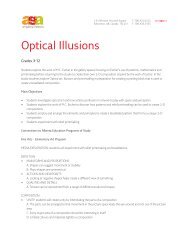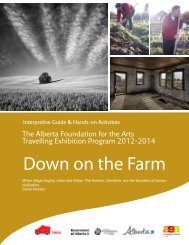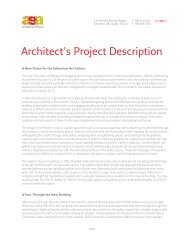A Bird in the Hand - Art Gallery of Alberta
A Bird in the Hand - Art Gallery of Alberta
A Bird in the Hand - Art Gallery of Alberta
- No tags were found...
You also want an ePaper? Increase the reach of your titles
YUMPU automatically turns print PDFs into web optimized ePapers that Google loves.
The <strong>Alberta</strong> Foundation for <strong>the</strong> <strong>Art</strong>s Travell<strong>in</strong>g Exhibition ProgramCross-Curricular ConnectionsScience (Grades 1-9)1.4 Students will show growth <strong>in</strong> acquir<strong>in</strong>g and apply<strong>in</strong>g a respect for liv<strong>in</strong>g th<strong>in</strong>gs and environments, andcommitment for <strong>the</strong>ir care.1.5 Creat<strong>in</strong>g Colour: Students will explore coloured materials, learn<strong>in</strong>g about different colours, how <strong>the</strong>yare created, what happens when <strong>the</strong>y are mixed and how <strong>the</strong>y can be transferred from one material toano<strong>the</strong>r. Students will learn to dist<strong>in</strong>guish and describe colours and work with a variety <strong>of</strong> materials tocreate, modify and apply colours. In <strong>the</strong> process, students learn that different materials have particularproperties and that <strong>the</strong> properties and <strong>in</strong>teractions <strong>of</strong> materials have to be taken <strong>in</strong>to account when <strong>the</strong>yare used for a specific purpose.1.6 Seasonal Changes: Students will describe seasonal changes, and <strong>in</strong>terpret <strong>the</strong> effects <strong>of</strong> seasonalchanges on liv<strong>in</strong>g th<strong>in</strong>gs.1.10 Senses: Students will describe <strong>the</strong> role <strong>of</strong> <strong>the</strong> human senses and <strong>the</strong> senses <strong>of</strong> o<strong>the</strong>r liv<strong>in</strong>g th<strong>in</strong>gs, <strong>in</strong>enabl<strong>in</strong>g perception and action.1.11.6 Needs <strong>of</strong> Animals and Plants: Students will identify <strong>the</strong> requirements <strong>of</strong> animals to ma<strong>in</strong>ta<strong>in</strong> life;i.e., air, food, water, shelter, space; and recognize that we must provide <strong>the</strong>se for animals <strong>in</strong> our care.2.10.8 Small Crawl<strong>in</strong>g and Fly<strong>in</strong>g Animals: Students will identify ways <strong>in</strong> which animals are consideredhelpful or harmful to humans and to <strong>the</strong> environment. Students will describe <strong>the</strong> relationships <strong>of</strong> <strong>the</strong>seanimals to o<strong>the</strong>r liv<strong>in</strong>g and nonliv<strong>in</strong>g th<strong>in</strong>gs <strong>in</strong> <strong>the</strong>ir habitat, and to people.3.10 Animal Life Cycles: Students will describe <strong>the</strong> appearances and life cycles <strong>of</strong> some commonanimals, and identify <strong>the</strong>ir adaptations to different environments6.5 Air and Aerodynamics: Students will describe properties <strong>of</strong> air and <strong>the</strong> <strong>in</strong>teractions <strong>of</strong> air with objects<strong>in</strong> flight.6.5.6 Students will describe means <strong>of</strong> propulsion for fly<strong>in</strong>g animals and for aircraft.7. D.1 Structures and Forces: Students will describe and <strong>in</strong>terpret natural structures, <strong>in</strong>clud<strong>in</strong>g <strong>the</strong>structure <strong>of</strong> liv<strong>in</strong>g th<strong>in</strong>gs and <strong>the</strong> structures created by animals (e.g., birds’ nests).9. A.1. Biological Diversity: Students will <strong>in</strong>vestigate and <strong>in</strong>terpret diversity among species and with<strong>in</strong>species, and describe how diversity contributes to a species survival. Students will identify examples <strong>of</strong>niches, and describe <strong>the</strong> role <strong>of</strong> variation <strong>in</strong> enabl<strong>in</strong>g closely related liv<strong>in</strong>g th<strong>in</strong>gs to survive <strong>in</strong> <strong>the</strong> sameecosystem (e.g., <strong>in</strong>vestigate different bird species found <strong>in</strong> a local park ecosystem, and <strong>in</strong>fer how each isadapted to life with<strong>in</strong> that ecosystem).9. A.3. Biological Diversity: Students will describe <strong>in</strong> general terms, <strong>the</strong> role <strong>of</strong> genetic materials <strong>in</strong> <strong>the</strong>cont<strong>in</strong>uity and variation <strong>of</strong> species characteristics; and <strong>in</strong>vestigate and <strong>in</strong>terpret related technologies.Students will dist<strong>in</strong>guish between, and identify examples <strong>of</strong>, natural and artificial selection (e.g., evolution<strong>of</strong> beak shapes <strong>in</strong> birds).AFA Travell<strong>in</strong>g Exhibition Program, Edmonton, AB Ph: 780.428.3830 Fax: 780.421.0479youraga.ca
















